Long-Ago Salmon Adventures in Alaska
Reflections on trips I took to Kodiak Island and the Yukon River, plus a recipe for salmon burgers
Today, I get a bit introspective. Reflective. A touch nostalgic. This is inspired by a couple of recent experiences that made clear to me how deeply impacted I was by two long-ago adventures up in Alaska. They enriched my appreciation of Alaska’s salmon in ways I’m not always fully aware…until I hear myself spontaneously recounting memories and impressions from those trips, as in the two examples below. If you’re just here for the salmon burgers, you can hop to the end. I’m planning an issue devoted to cooking seafood with herbs for the next newsletter in a couple of weeks.
And a quick event note, too, for anyone who may be in the Sun Valley area in a few weeks. I’m returning to teach at the Sun Valley Culinary Institute and one of my classes always focuses on seafood. This time the class is all about Dungeness, with stories and basic how-tos, along with four recipes making the most of that delectable crab.
There I was, standing in front of about 30 people, introducing the fourth and final recipe in a class I taught last summer at the Sun Valley Culinary Institute. After I had demonstrated halibut, sole, and trout, each with a different cooking technique, it was time for the salmon recipe. And before I know it—before I get to the practical part about the basics of pan-frying, where I’d intended to begin—I’m traveling a few decades back in time and about 3,000 miles north to Kodiak Island in Alaska, and taking them all with me for that ride.
I don’t know exactly what sparked that almost reverie-like tangent, talking about a week I spent with salmon-fishing families in the Alitak Bay area of Kodiak Island in the summer of 1997. A few minutes later, when I was done sharing perspectives about what that time taught me about the beauty and value of Alaska’s salmon, I said as much as I looked out over the audience…“wow, I’m not sure where that came from!”
The Kodiak Island trip resulted in a photo-heavy article in the summer 1998 issue of Simply Seafood magazine, in which I wrote, “It was an endless collection of experiences crammed into one little week—and a great opportunity to learn just what goes into the harvest of the wild salmon that are so prized—both here and abroad.” Way back in my second issue of Seafood Savvy, I wrote a bit about that Kodiak experience, including description of the amazing potluck dinner I and the other journalist on that trip were treated to as our week on the island came to a close.
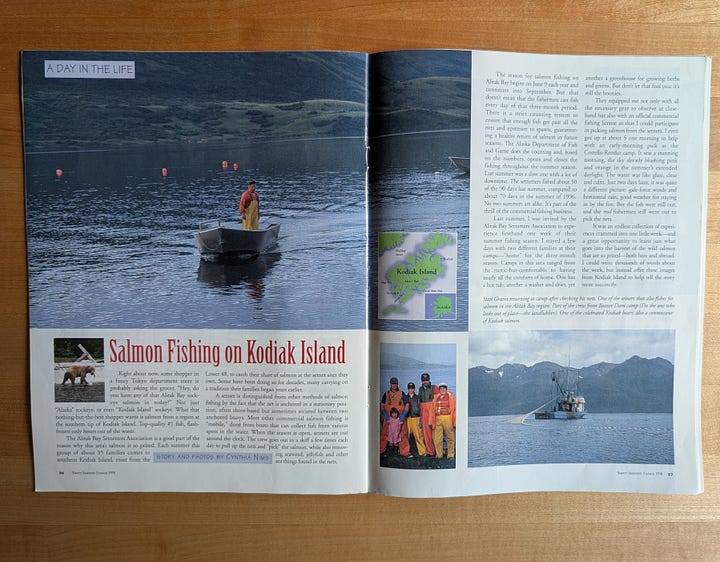
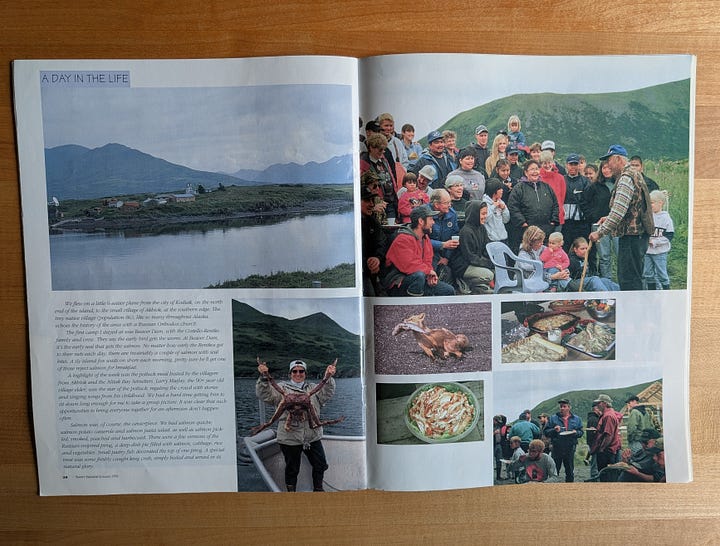
On one hand, that cooking class moment surprised me—I hadn’t planned on talking about Kodiak Island in the class discussions. On the other hand, I shouldn’t be surprised at all. The moment reflected how much I learned and how the trip became an important, lasting touchpoint in my appreciation of seafood.
I had a similar experience a couple of months ago, when I was on the panel for an event in Seattle that focused on food traditions of the Pacific Northwest—which was a fabulous and dynamic conversation. Near the end of our talk, the moderator asked me what defines Northwest cuisine, exactly. It wasn’t one of the questions we’d chatted about ahead of time, but is definitely one I’ve thought about many, many times over the last few decades.
It felt a bit daunting to try addressing it succinctly in a few minutes. The perspectives I shared focused primarily on the outstanding array of foods that grow and thrive here in the Northwest, how lucky we are to have so many amazing products to choose from. My POV: it’s all about the ingredients, less about a framework of traditional recipes that we cook from.
Then I wrapped up with this thought: our giddiness around outstanding seasonal, regional foods is absolutely understandable. I’m right there too, giddy about the berries, the wild mushrooms, the rhubarb/sweet onions/garlic scapes/so so much from local farms and gardens. And of course, the salmon, oysters, and other seafood.
And, with that giddiness, I said that I felt there should be a dose of reverence about those foods as well. Awareness of the traditions, history, and people behind the food. An understanding of the foods’ value beyond simply how delicious they are and how fun to create meals with.
Then came another reverie of sorts, going back 21 years and even further north in Alaska, to the Yukon River. I was there in June of 2004, doing research while working on my salmon cookbook.
What I experienced on the Yukon River was different from on Kodiak Island. The latter gave me some up-close insights about commercial salmon fishing. The former was all about subsistence fishing—a profound and moving tradition to witness.
Traveling with my dear friend, Scott Wellsandt, who had been Simply Seafood’s staff photographer—we visited a number of fish camps where Yup’ik families gather each summer to catch and preserve salmon that will sustain them for the months to come. They took their ulu knives to the fish with ease, preparing them for drying, smoking, salting, and preserving in jars.
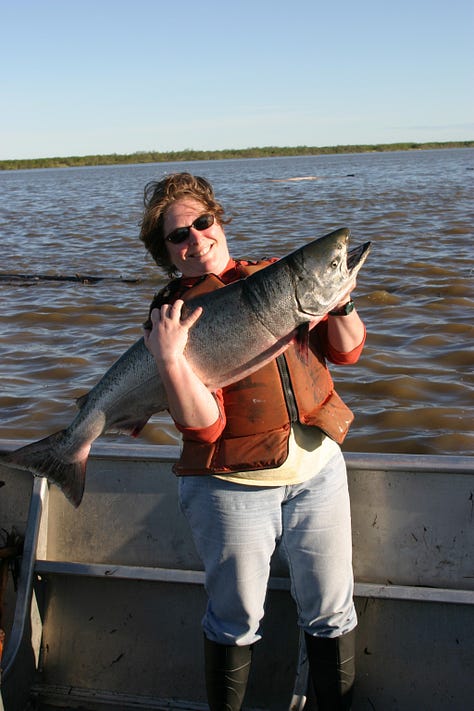
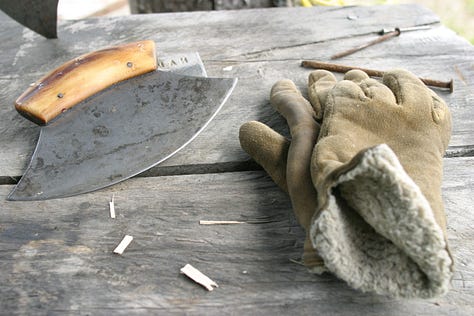

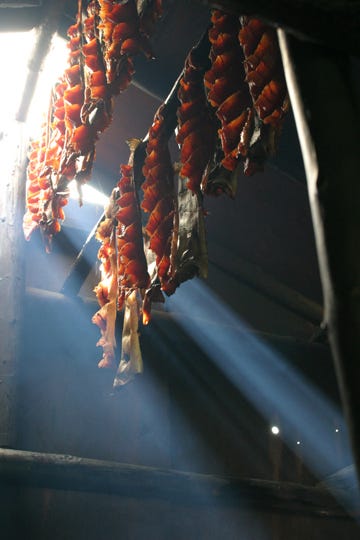

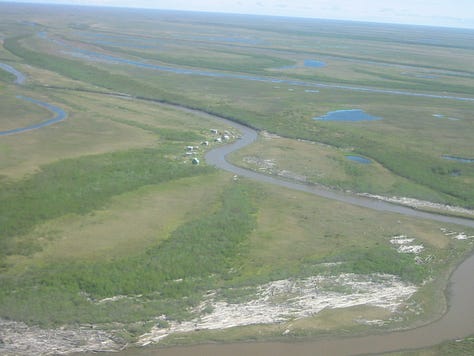
I did my best to encapsulate the Yukon River trip in an essay I included in that salmon cookbook, here are a couple of excerpts from it:
Having visited the villages of Emmonak and Kotlik, it’s easy to understand how valuable the subsistence traditions still are. They may have satellite TV and outboard motors, but neither alters the fact that they are still incredibly remote. Everything in those towns came in by boat or plane, no road system connects them with other towns. Kotlik had a network of boardwalks for ATV and foot traffic only, Emmonak’s few roads are populated by some well-worn vehicles that originally came in by barge.
Everyone I spoke with about these fish camp traditions said that they see no chance of the practice waning in the face of modern times. In another Pacific Coast Native setting in British Columbia, I saw another camp, called Kyel (“Seaweed Camp”) where my guide, a Gitga’at Indian, goes with his family every May to harvest and dry seaweed and halibut. He explained the fish camp traditions to me as a “cycle that can’t be broken, it’s important for the children to learn and important for the elders to share what they know.” So, the succession of generations will continue to pass on subsistence traditions well into the future.
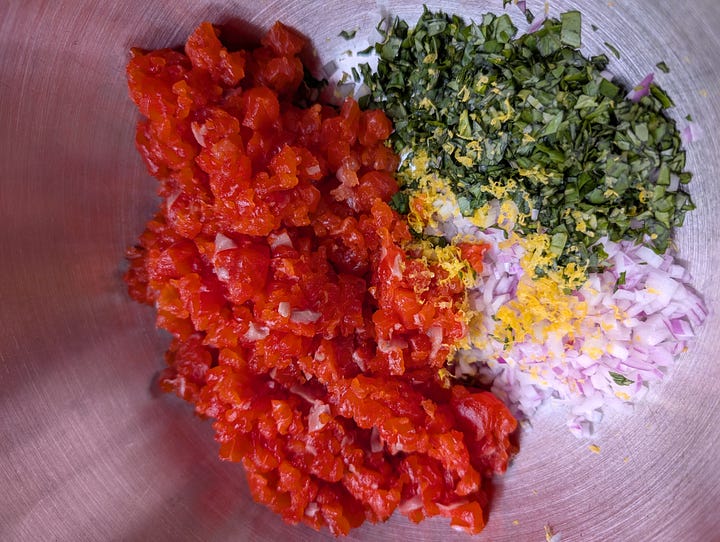
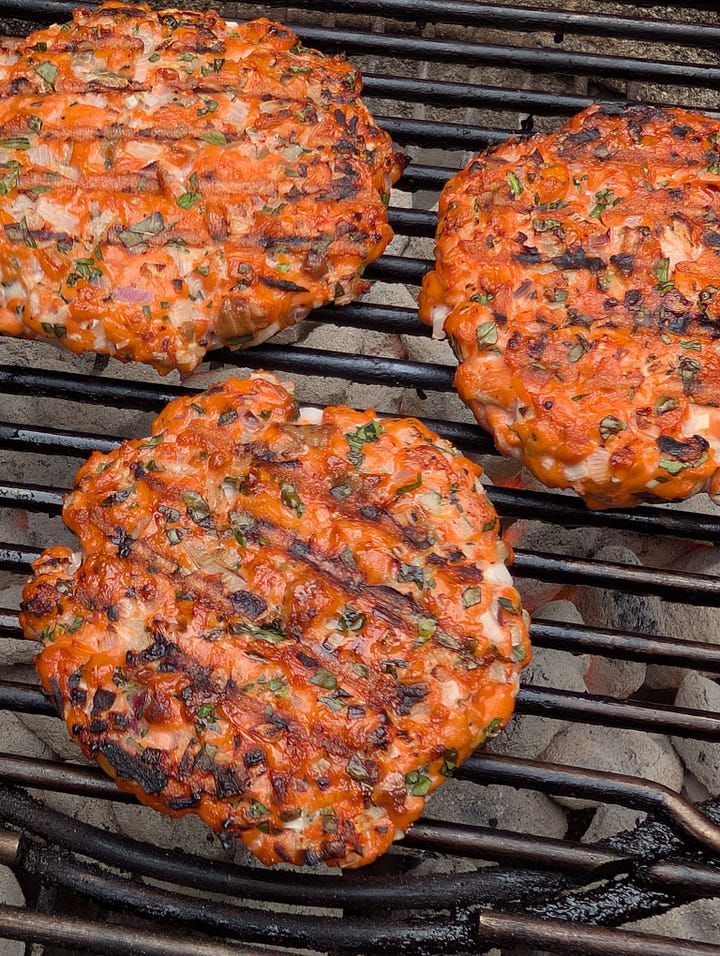
Salmon Burgers with Basil Mayonnaise
recipe from Salmon in the Northwest Homegrown Cookbook Series
I much prefer the texture of these burgers when the salmon is hand chopped; there will inherently be pieces that are a bit larger, other parts very finely chopped, so together they create a good overall texture that will hold together as a burger. If you really want to, you can cut the salmon in chunks and pulse it in a food processor but it’s easy to go from “chopped” to “purée” without meaning to, so try to avoid over-processing.
True confessions: for all my culinary experience and skill, I still fail at homemade mayonnaise now and then. As I did when remaking this recipe last week. Rather than dwell on the frustration, I pulled out my Best Foods and added a good dose of minced basil to it. Which you can certainly do to. Best to do so an hour or two ahead, if you can swing it, for more pronounced flavor.
1 1/2 pounds salmon fillet, skin and pin bones removed
1/2 cup minced red onion
2 tablespoons minced basil
1 teaspoon finely grated lemon zest
1 teaspoon kosher salt
1/4 teaspoon freshly ground black pepper
4 Kaiser rolls or hamburger buns
4 crisp lettuce leaves
1 medium tomato, cored and sliced
Basil Mayonnaise
1 egg yolk
1 tablespoon white wine vinegar
3/4 cup olive oil (not extra virgin)
3 tablespoons minced basil
Salt and freshly ground black pepper
For the basil mayonnaise, combine the egg yolk and vinegar in a medium bowl and whisk to blend. Begin adding the olive oil a drop at a time, whisking constantly, until the yolk begins to turn pale and thicken slightly, showing that an emulsion has begun to form. Continue adding the rest of the oil in a thin, steady stream, whisking constantly, then whisk in the basil with salt and pepper to taste. Refrigerate until ready to serve; it will have a fuller flavor if made at least an hour before serving and can be made a couple of days in advance.
Preheat an outdoor grill.
Cut the salmon fillet into medium dice and put it in a low mound on the cutting board. Cut across the pile in different directions, reforming a low mound a couple more times along the way, until most of the salmon is finely chopped and it has a consistency that holds together when you squeeze some in your hand. Put the salmon in a large bowl with the onion, basil, lemon zest, salt, and pepper. Evenly mix the ingredients with your hands, then form the salmon mixture into 4 burgers, about 4 inches across and 1 inch thick.
Rub the grill grate lightly with oil and grill the burgers until they are just opaque through and lightly browned, 3 to 4 minutes per side. While the burgers are cooking, lightly toast the buns on the outer edge of the grill, if you like.
To serve, spread some of the basil mayonnaise on the bottom buns and top with the salmon burgers. Add the lettuce, sliced tomato, and the top buns. Serve right away.
Makes 4 servings





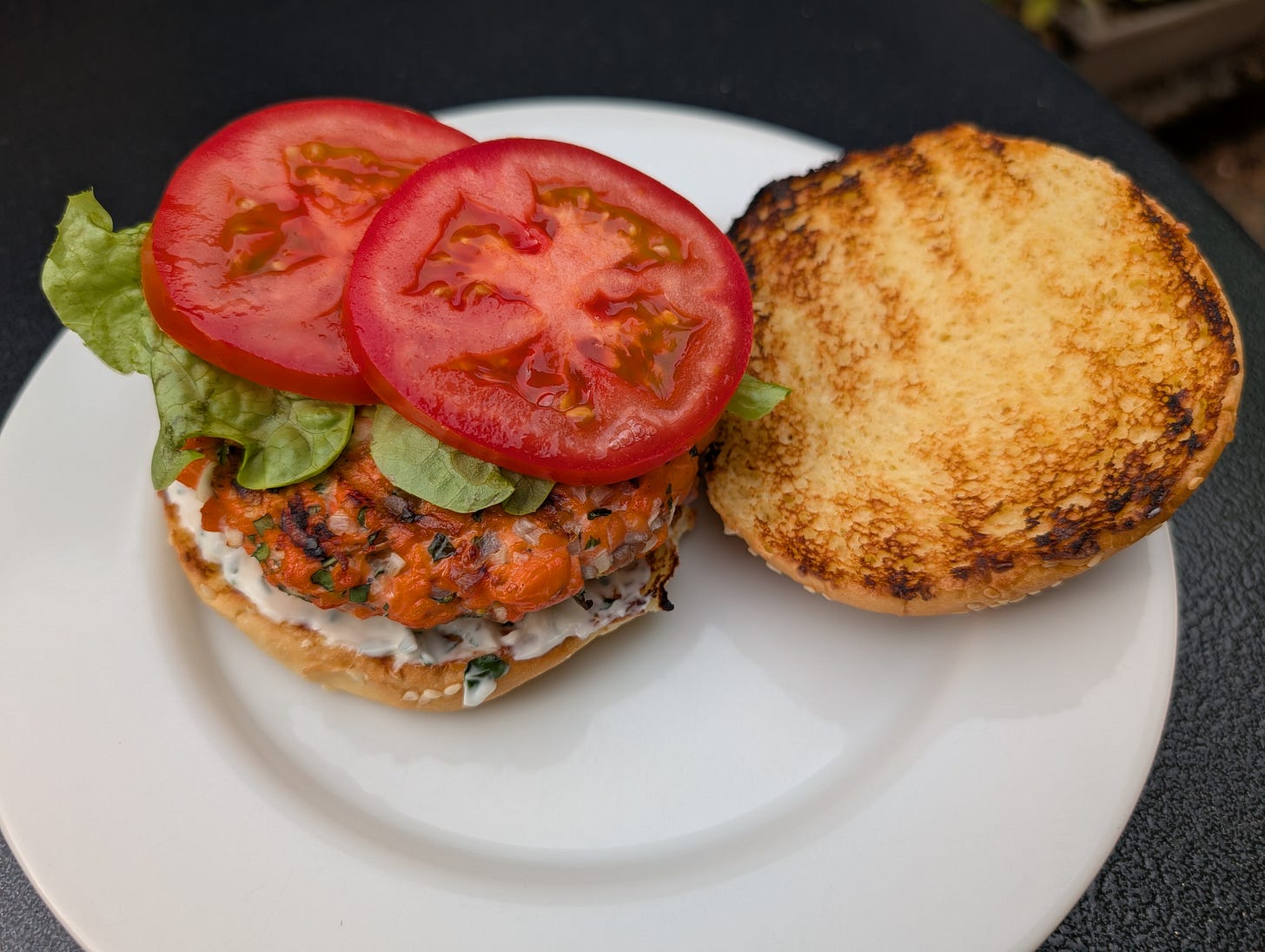
Oh, goodness! I worked in the cannery at Alitak on Kodiak Island for 5 summers to pay for college. Seaplane in, seaplane out. Bunkhouse living, and meals in the mess hall!
I remember when you took that trip to the Yukon.